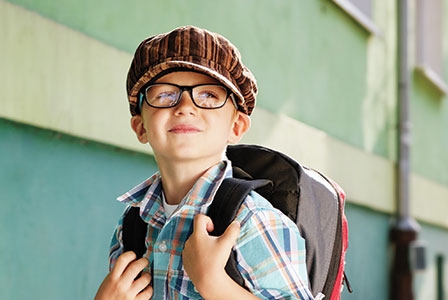
As a child grows, so do the child\’s eyes. Now\’s the time to get an annual eye exam to determine any potential vision problems.
New clothes, fresh school supplies, and a fridge full of healthy ingredients to make nutritious lunches—you’ve thought of everything. But before you embark on one last camping trip, make an appointment to have your child’s eyes examined. It’s the first step to a successful school year.
Catch vision problems early
The Canadian Association of Optometrists recommends children have a complete eye exam at six months, before starting kindergarten, and annually throughout the school years to ensure best eye health and development.
“By six months of age a child has reached several milestones,” says Jim Asuchak, a doctor of optometry in Lethbridge, Alberta. “Also at that age, vision is the dominant sense, so it forms the basis for perceptual, cognitive, and social development.”
Optimal eyesight equals better learning
As a child’s body grows and changes, so do the eyes. That’s why annual eye exams are so important, especially as homework increases and children have greater demands on their vision.
“Prescriptions can change from year to year,” says Asuchak. “In the case of farsightedness, where the eye is too short, the eye can grow and lengthen, and the farsightedness can be outgrown if it’s a small amount. The child may not need glasses anymore.
“But then as the eyes continue to develop, he can become nearsighted, where the eye becomes too long, and he may need glasses for the opposite reason.”
Vision problems can also be mistaken for behaviour or attention deficit disorders. A child with impaired vision needs to work much harder to understand what’s being taught in class. The frustration he feels may lead to headache, fatigue, and irritability. Many times he won’t realize he has a vision problem and assumes everyone is experiencing the same issues.
Get out and play!
A 2013 Taiwanese study found that exposure to sunlight reduces the chance of developing myopia, or nearsightedness. Myopia was thought to be a genetic disorder, but researchers have discovered that bright sunlight might be key in controlling the condition.
Sunlight stimulates the release of dopamine from the retina, which helps reduce eye growth typical in myopic eyes. The study showed that sending a group of children outside daily for recess resulted in a significant reduction in the development of nearsightedness compared to the group who stayed inside.
Use the 20/20/20 rule
Parents know how difficult it is to convince kids to drop the electronics in favour of outdoor play. “Computer vision syndrome is a new term optometrists use for looking at screens too long,” says Asuchak.
“The eyes tend to point inward, which induces a lot of strain, plus the brightness of the screen contributes to eye fatigue. We recommend the 20/20/20 rule: for every 20 minutes of screen time, take a 20-second break and look 20 feet away.”
Choosing the right frames
If it becomes necessary for your child to wear prescription glasses, have your optometrist suggest the right size for your child’s face and make necessary adjustments for the best fit. Your child won’t wear glasses if they’re not comfortable.
Avoid choosing adult frames for your child to grow into. Make sure the frames do not touch the cheeks or eyelashes, and choose lightweight polycarbonate lenses with built-in UV protection. Nearsighted children usually adjust to their glasses quickly, while those who are farsighted or have astigmatism might take a little longer. Persistence is key.
Best nutrients for healthy eyes
Getting the right nutrients is an important part of eye health. If your child is a picky eater, supplements are available to help fill any of these nutritional gaps.
Beta carotene
Bright yellow and orange fruits and vegetables are high in beta carotene, a form of vitamin A. Choose cantaloupe, apricots, carrots, and sweet potatoes for maintaining normal vision, especially in low light. The darker the colour, the higher the beta carotene content.
Lutein and zeaxanthin
Green leafy vegetables, spinach, corn, and egg yolks contain optimal amounts of lutein and zeaxanthin, two forms of carotenoids that help prevent macular degeneration in later years. Kiwi fruit, grapes, zucchini, and oranges are also good sources.
Omega-3 fatty acids
Wild salmon, tuna, and ground flaxseed are rich in omega-3 fatty acids that may help relieve dry eyes by reducing inflammation.
Vitamin E
Wheat germ, almonds, sunflower seeds, and cooking with vegetable oil provide high amounts of vitamin E, an antioxidant that protects eyes from free radicals that can damage healthy tissue over time. Sprinkle wheat germ on yogurt or cereal, and tuck a small bag of nuts into coat pockets for your children to snack on as they walk to school.
When to see the optometrist
Alongside the recommended eye exams for children at six months, before starting kindergarten, and every year afterward, visit the optometrist if your child
- can’t see the blackboard or squints when reading signs
- holds reading materials too close
- sits too close to the television
- has one or both eyes that appear crossed
- develops a headache while reading
- constantly rubs eyes
- uses a finger to maintain place while reading
- assumes an unusual posture to favour one eye over the other
- is falling behind academically
- confuses or omits words when reading
Typical childhood eye conditions
Myopia
- commonly called nearsightedness
- allows eyes to see things nearby clearly, while objects far away appear blurry
Hyperopia
- also known as farsightedness
- lets you see far away, but objects close up are somewhat out of focus
Astigmatism
- causes blurry vision both near and far
- happens when the cornea (front surface of the eye) or the lens (inside your eye) has surface areas that are flatter in places or uneven instead of being smooth all over
- can be present at birth and worsen over time
- can be diagnosed in conjunction with myopia or hyperopia
Amblyopia
- also known as lazy eye
- affects 2 to 4 percent of children under the age of six
- caused by a difference in prescription between two eyes or if a weaker eye turns inward
- the brain shuts off the weak eye, and nerve connections are weakened
- can be corrected with glasses, an eye patch, or eye exercises
- the earlier amblyopia is treated, the better
